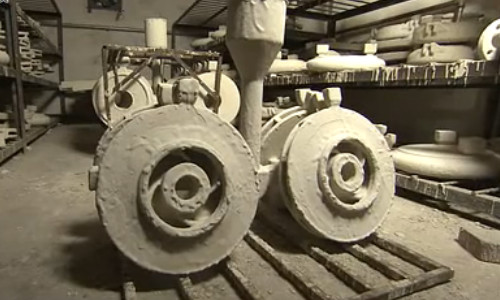Effect and function of lost foam coating
Interface reaction of metal/foam model/coating/molding sand: When the liquid metal flows in and contacts the foam model, the melting and decomposition of the foam begins. The cavity left by the melting of the model and the metal filling is actually a “replacement reaction”. There is a gap between the flowing metal and the model, which is filled with the original air in the foam and the products of the melting and decomposition of the foam. The hydrocarbons produced by the melting and decomposition of the foam contain both liquid and gas, and their composition varies with temperature. These liquids and gases must be absorbed by the coating at a specific speed and partially or completely enter the surrounding sand. When casting aluminum, the aluminum liquid melts EPS, and the liquid decomposition products are pushed to the cavity wall, that is, near the coating. After reaching a certain temperature, the liquid decomposition products will wet the coating and immediately penetrate the coating when the coating temperature rises to between 325℃ and 400℃; if the air permeability of the coating is appropriate, when the temperature continues to rise, EPS can be gasified and decomposed and enter the sand through the coating. Since the temperature is not very high when casting aluminum, the process of the liquid decomposition products wetting and penetrating the coating will continue after the metal pouring stops. The permeability of the coating should be designed appropriately so that the air and the gas produced by the decomposition of the foam can be discharged before the liquid decomposition products completely wet and cover the entire coating to avoid casting defects. In the case of cast iron, the temperature is high, the EPS is melted to produce more gas and less liquid, so there will be less liquid decomposition products at the metal/coating interface and more gas needs to be discharged through the coating. The fluidity of the liquid metal and the process of filling the cavity depend to a large extent on the discharge of the decomposition products. At the temperature of casting aluminum, the discharge of liquid decomposition products is the key; at the temperature of cast iron and steel, the escape of gaseous products is more important. It can be seen that the coating plays a dual role in controlling mass transfer and heat transfer in the lost foam casting process. In the process of mass transfer through the coating, the transfer of liquid and gaseous decomposition products coexists and competes with each other. The result of the interaction is to affect and determine the mechanism and speed of cavity filling. If the liquid decomposition products wet and completely cover the entire coating too quickly, air and gas decomposition products will accumulate between the liquid metal and the coating, and the resulting pressure will slow the flow of the metal and may even cause a cold shut. On the contrary, if the gas escapes the coating too quickly and the liquid decomposition products wet and penetrate the coating too slowly, the metal will flow too quickly and the liquid decomposition products will be drawn into the flowing metal liquid, eventually forming pores and surface defects. On the other side of the coating is sand, and the coating mechanically supports the foam model to protect it from compression deformation or fracture when the sand is injected and vibrated. During the casting process, the coating is subjected to compressive stress from both the sand and the gas and liquid generated by the decomposition of the flowing metal and the foam model. Although the two pressures are in opposite directions and can offset each other to some extent, the coating should still have enough strength to withstand thermal shock and stress and allow some of the decomposition products to escape at the same time. The heat and substances transmitted through the coating partially enter the sand around it, the temperature of the sand rises, and some decomposition products remain in the sand.
The refractory coating for lost foam casting is a barrier between the foam model and the sand. During the pouring process, the refractory coating is a part of the entire system of liquid metal/foam model/coating/molding sand. Therefore, a full understanding of the series of reactions that occur in the entire system during the pouring process will help understand the role and performance requirements of the coating in the lost foam casting process.
(1) The coating for lost foam casting must have high-temperature permeability. The high-temperature permeability of the coating directly affects the quality of the casting to a large extent. High temperature means that the refractory property of the coating must be good and the thermal expansion coefficient must be low. The permeability of the coating is to ensure that the gas generated by the gasification of the model can pass through the coating and be pumped away by the vacuum pump through the gap between the molds.
(2) The coating for lost foam casting must have good coating properties. The coating is relatively thick. Therefore, the coating must have the ability to plastically deform and strictly control the flowability of the coating. For coatings with thermosetting resin as the binder, a small amount of thixotropic agent can be added to improve the coating’s coating properties.
(3) Lost foam casting coatings should have good wettability. Adding an appropriate amount of surfactant and binder to the coating can obtain excellent castings after coating.
As mentioned above, the role of lost foam coatings is to support and protect the foam model, prevent liquid metal from penetrating into sand and sticking to sand, absorb decomposition products and allow decomposition gases to pass through the coating, maintain the integrity of the cavity formed after the foam model evaporates, and keep the heat of the liquid metal from dissipating quickly. Therefore, the use of lost foam coatings can reduce the surface roughness of castings, ensure the accuracy of castings, reduce or prevent defects such as sand sticking, sand holes, pores, metal penetration, cold shut, inability to pour, and carbon deposition. Therefore, lost foam coatings should have sufficient refractoriness, certain mechanical strength, appropriate thermal insulation and thermal conductivity, suitable air permeability and ability to absorb liquid decomposition products, smooth surface, sufficient brushing performance, and no chemical reaction with the foam model. Improve the coating’s coating properties, flowability, air permeability, refractoriness, strength, etc.







